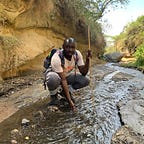Bridging East Africa’ formal — informal financial services divide
can we have the rich of the Chamas and informal savings group together with the formal financial system and technology?
Kenya’s formal inclusion looks pretty, the financial inclusion industry has been has been great at talking up its achievements over the past 10 years. Here, 75.3% of Kenyans are now formally included, a 50.3% increase from 19 years ago. Official statistics on mobile phone penetration is up to 80.5% of the population and there is general consensus, the mobile phone has been central to expanding formal financial services to the — unbanked and under banked. The numbers are pretty awesome.
In February, FSD Kenya’s chart of the week featured an interesting pattern.
The red line marks the axis between the formal (prudential) and informal financial services alternatives. The largest source of credit for the bottom 40% populate the informal segment — SACCOs ,MFIs, Peer to peer, community groups. Dotting the top in blue are the banks and mobile banking lending products Mshwari.
So, there is more going on besides what the numbers say about formal financial inclusion.
Appreciating the informal sector’s financing alternatives
I got a sense of this gap between what the reports say and what was on the ground in 2015/2016 as part of 2 immersive fieldwork projects — Nyeri Mama’s Financial Diaries and later same year as part of Borderland Biashara: Mapping the cross border, national and regional trade in the East African informal economy project. I got to meet and spend time with biashara people, mama biashara, informal traders at the borderlands, boda boda guys, brokers and 65 year old Wangari — all in their natural setting — the mostly rural and cash intensive informal economies at the borderlands.
I found out that 90% of them had a basket of alternative credit, investment, insurance and savings informal financial products at their disposal — up to 8 different volatility management groups. The flavor of these alternatives ranged from extreme formal prudential to extreme informal.
Wangari, from Nyeri, for example, did not have a bank account but, was part of
- 1 Micro-finance bank,
- 2 Cooperatives
- 1 ROSCA (Rotating Savings and Credit Association
- 1 Chama (savings group)
- a Catholic church group and
- a modest Nokia mobile phone with Mobile wallet (Mpesa) and mobile wallet bank (Mshwari)
At the borderlands of Busia and Malaba between Kenya and Uganda, close to 96% of 100 biashara interviewees were part of at least 3 savings groups, besides their mobile phone. There was almost always one savings group that was part of their trade or craft networks.
Bridging the Gap
When we look at the under banked strictly through the lenses of a bank, we miss out on the rich diversity of community bank-like products already at their disposal. When their options are labelled informal, the tone turns to one of expanding the larger banking formal system, at the expense of our dear Chamas.
My suggestion for the present day efforts to push towards financial formalization, is to instead transform into a pull towards formality. Is there a middle ground? Where we can have the rich of the Chamas and savings group together with the formal financial system? Or where we can have a blend of the rich of the savings groups with technology?
Yes.
We have examples from East Africa’s Kenya and West Africa’s Chad
- Equity bank directly engages registered savings groups at the Busia Malaba border, a trader’s Chama. A credit officer from a local branch attends weekly meetings with the group, and liaises between Equity Bank and the Chama. The bank facilitates loans guaranteed by the group as a unit.
“Muranga county seeks to ease unemployment with cow loans” — Daily Nation
- Ng’ombe loan, by Muramati and Unaitas SACCO, was an unconventional loan product much closer to the realities of a rural Muranga. Youth in this county received high-yielding, pregnant dairy cows on credit, and were to repay the loan through milk deliveries to processors. An expectant cow as the loan principal, with repayments priced in daily milk deliveries. How cool!
“TigoPaare — People’s Banks for Communities across Africa” — Balancing Act Africa
- In Chad, Paare are the equivalent of Chama group savings plans in East Africa. TigoPaare is a group wallet that adds a ‘group layer’ on top of standard mobile money, to deal with common funds, trust and other group initiatives. The wallet helps informal cattle trades look after their income from cattle sales, with the functionality to make loans to members. The pilot attracted 19,000 users, including community mutual funds, cotton producers cooperatives, churches, market sellers and women’s groups.
*this article first appeared on Niti Bhan blog
